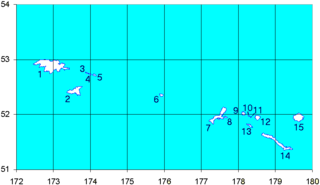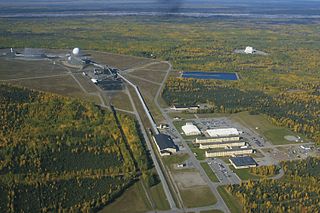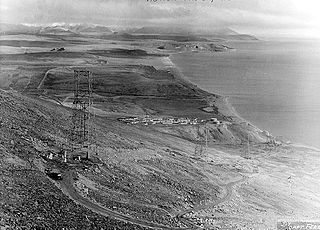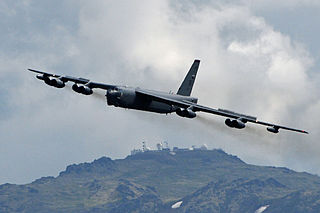
Tropospheric scatter, also known as troposcatter, is a method of communicating with microwave radio signals over considerable distances – often up to 500 kilometres (310 mi) and further depending on frequency of operation, equipment type, terrain, and climate factors. This method of propagation uses the tropospheric scatter phenomenon, where radio waves at UHF and SHF frequencies are randomly scattered as they pass through the upper layers of the troposphere. Radio signals are transmitted in a narrow beam aimed just above the horizon in the direction of the receiver station. As the signals pass through the troposphere, some of the energy is scattered back toward the Earth, allowing the receiver station to pick up the signal.

Shemya or Simiya is a small island in the Semichi Islands group of the Near Islands chain in the Aleutian Islands archipelago southwest of Alaska, at 52°43′27″N174°07′08″E. It has a land area of 5.903 sq mi (15.29 km2), and is about 1,200 miles (1,900 km) southwest of Anchorage, Alaska. It is 2.73 miles (4.39 km) wide and 4.32 miles (6.95 km) long.

Clear Space Force Station is a United States Space Force radar station for detecting incoming ICBMs and submarine-launched ballistic missiles to NORAD's command center and to provide Space Surveillance data to the United States Space Force. Clear's AN/FPS-123 Upgraded Early Warning Radar is part of the Solid State Phased Array Radar System (SSPARS) which also includes those at Beale AFB, Cape Cod Space Force Station, RAF Fylingdales and Thule Site J. The "historic property" was one of the Alaska World War II Army Airfields and later a Cold War BMEWS site providing NORAD data to Colorado's BMEWS Central Computer and Display Facility (CC&DF).

Microwave transmission is the transmission of information by electromagnetic waves with wavelengths in the microwave frequency range of 300MHz to 300GHz(1 m - 1 mm wavelength) of the electromagnetic spectrum. Microwave signals are normally limited to the line of sight, so long-distance transmission using these signals requires a series of repeaters forming a microwave relay network. It is possible to use microwave signals in over-the-horizon communications using tropospheric scatter, but such systems are expensive and generally used only in specialist roles.

Tatalina Air Force Station is a closed United States Air Force General Surveillance Radar station. It is located 13 miles (21 km) west-southwest of McGrath, Alaska.

Tin City Long Range Radar Site is a United States Air Force radar station. It is located 106.3 miles (171.1 km) west-northwest of Nome, Alaska. It is the former Tin City Air Force Station.
Big Mountain Air Force Station is a military use airstrip located near Big Mountain, in the Lake and Peninsula Borough of the U.S. state of Alaska. The airstrip was built to support the Big Mountain Radio Relay Station, an abandoned Air Force facility located 220 miles (350 km) southwest of Anchorage on the south shore of Iliamna Lake.

The North Atlantic Radio System (NARS) was a chain of 5 tropospheric scatter communication sites. It was an expansion of the former Distant Early Warning Line. NARS has been built for the United States Air Force (USAF) by Western Electric (AT&T) and its sites were maintained under contract by ITT Federal Electric Corporation. All NARS stations were supervised and controlled by the USAF, by agreement with the Canadian and Danish Governments.
Columbia Falls Air Force Station is a closed United States Air Force radar station in Washington County, Maine. Located 16.0 miles (25.7 km) northwest of Machias, Maine and 10.0 miles (16.1 km) north of Columbia Falls, it went operational in 1990 but was closed in 1997 and placed in "warm storage" with minimal maintenance. It was deactivated and placed in "cold storage" in 2002.
Moscow Air Force Station is a closed United States Air Force radar station in Somerset County, Maine. Located 6.0 miles (9.7 km) northeast of Moscow, Maine, it went operational in 1990 but was closed in 1997 and placed in "warm storage" with minimal maintenance. It was deactivated and placed in "cold storage" in 2002.
King Salmon Air Force Station is a closed United States Air Force General Surveillance Radar station. It is located 0.4 miles (0.64 km) west of King Salmon, Alaska.
Cape Newenham Air Force Station is a closed United States Air Force General Surveillance Radar station. It is located 67.5 miles (108.6 km) west-southwest of Togiak, Alaska.
Indian Mountain Air Force Station is a closed United States Air Force General Surveillance Radar station. It is located 15.8 miles (25.4 km) east-southeast of Hughes, Alaska.

Fort Yukon Long Range Radar Site is a radar site of the United States Air Force. It is located 1.6 miles (2.6 km) east-southeast of Fort Yukon, Alaska.

Kotzebue Air Force Station is a closed United States Air Force General Surveillance Radar station. It is located 4 miles (6.4 km) south of Kotzebue, Alaska.

Sparrevohn Air Force Station is a closed United States Air Force General Surveillance Radar station. It is located 356 miles (573 km) southwest of Fairbanks, Alaska.
Cold Bay Air Force Station is a closed United States Air Force General Surveillance Radar station. It is located 625 miles (1,006 km) southwest of Anchorage, Alaska.
Unalakleet Air Force Station is a closed United States Air Force General Surveillance Radar station. It was located 394 miles (634 km) west of Fairbanks, Alaska.

The Nike Site Summit is a historic military installation of the United States Army in Anchorage Borough, Alaska. The site, located in the Chugach Mountains overlooking Joint Base Elmendorf–Richardson, is the location of one of the best-preserved surviving Nike-Hercules missile installations in the state. The site's structures include a battery control area, a missile launch area, and several magazines. Units of the 43rd Air Defense Artillery Regiment, USARAL Artillery Group, United States Army Alaska, would have garrisoned the site. The site was built in 1957-58 and equipped with missiles in 1959. The site was in active service defending the United States from the threat of Soviet air strikes until it was decommissioned in 1979, after which sensitive militarily equipment was removed. The U.S. Army maintained the site into the 1980s before abandoning it. The site was listed on the National Register of Historic Places in 1996. A local non-profit group, Friends of Nike Site Summit, is actively attempting to preserve the site.
















